Dealing with car damage can be incredibly stressful, especially when you’re juggling daily life without your vehicle. At Car Repair Online, we understand the frustration of not knowing how long your car repair will take. You’re likely wondering, “how long will it take to repair my car?” and seeking clarity amidst the uncertainty. The repair duration can vary significantly based on the extent of the damage, the specifics of your car, insurance procedures, and various other factors.
For over two decades, Car Repair Online has been dedicated to providing clear, reliable information to car owners navigating the repair process. We believe that having realistic expectations is key to a less stressful experience. That’s why we’ve created this guide to explain car collision repair times, including typical durations for different repairs, the stages involved in the repair process, and the elements that influence how long it will take to get your vehicle back on the road.
Average Collision Repair Time
If you’re asking, “how long will it take to repair my car after an accident?”, the honest answer is that it truly depends on a range of variables, primarily the type and severity of the damage. Generally, auto body repair times can range from just a few hours to several weeks or even longer.
Because the timeframe for car repairs can vary so widely, we’ve compiled a straightforward table outlining average repair times for different levels of collision damage. This should give you a clearer picture of what to expect based on the type of repair needed.
| Type of Collision Repair | Average Time to Fix |
|---|---|
| Minor Collision Repair | 1-3 days |
| Major Collision Repair | 1 to 3 weeks |
| Paintless Dent Repair | 1-2 days |
| Bumper Repair/Replacement | 1-3 days |
| Fender Repair/Replacement | 1-4 days |
| Door Repair/Replacement | 2-4 days |
| Glass Replacement | 1-2 days |
| Suspension Repair | 2-3 days |
| Frame Straightening | 4 days – 2 weeks |
| Paint Repair (minor) | 2-4 days |
| Paint Repair (major) | 1-2 weeks |
| Airbag Replacement | 2-5 days |
| Engine Repair/Replacement | 1-4 weeks |
| Full Vehicle Restoration | 4-8 weeks or longer |
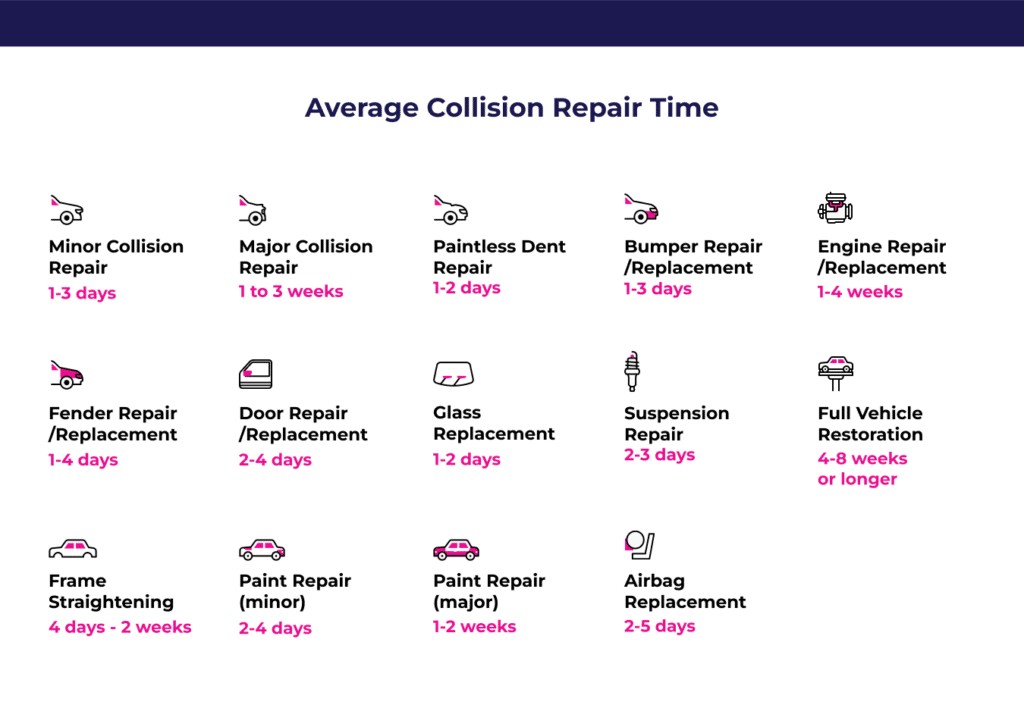

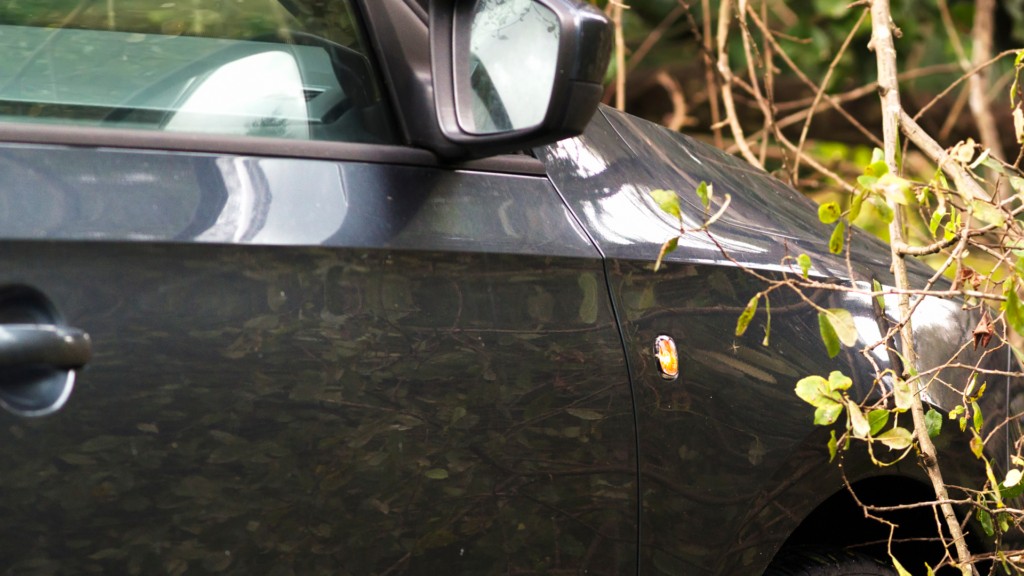
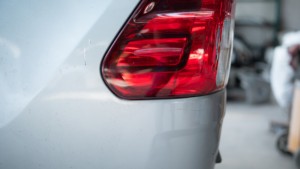
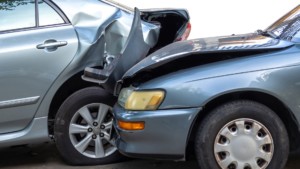
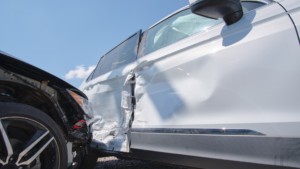
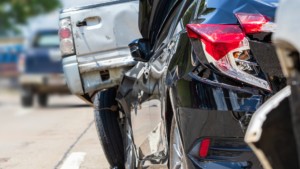
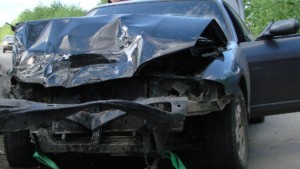


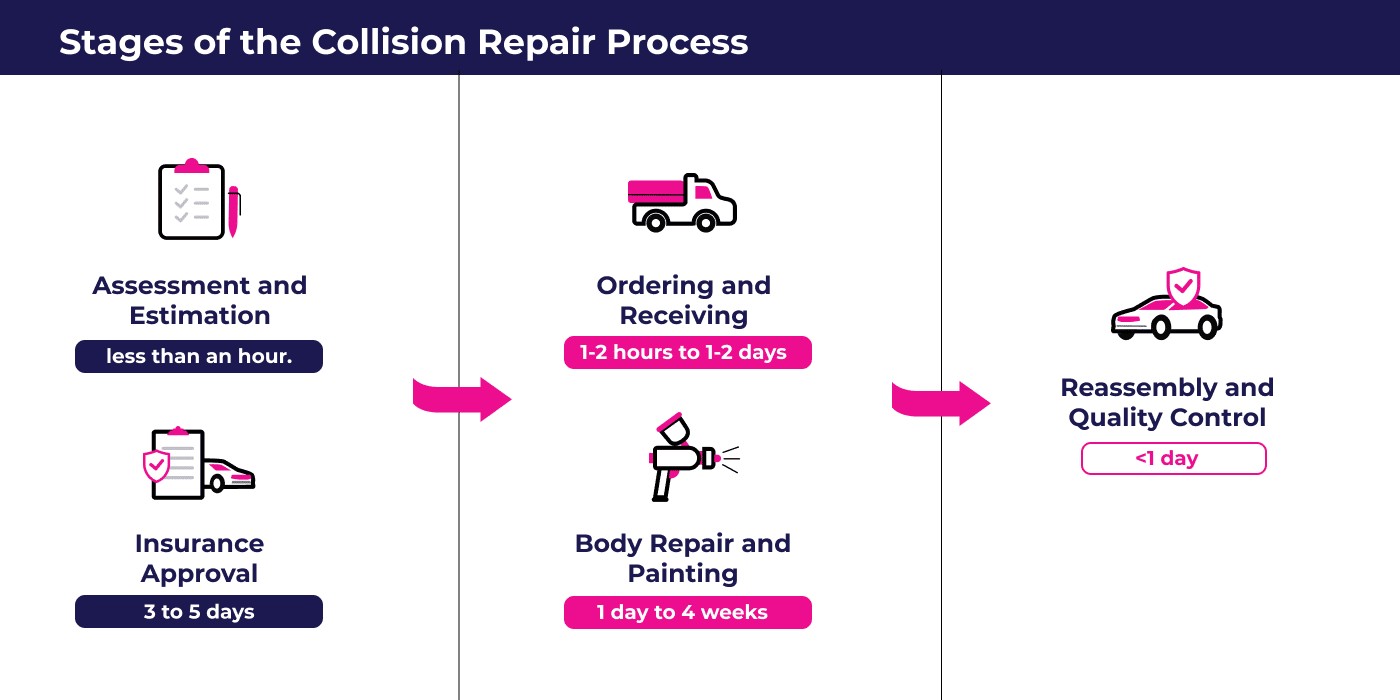

Minor vs. Major vs. Severe Collision Repair Times
Understanding the difference between minor, major, and severe collision repairs is crucial for estimating how long your car might be in the shop.
Minor Collision Repair
Minor collision repairs typically take 1 to 3 days and involve cosmetic fixes that don’t affect the structural integrity of your vehicle. These are usually straightforward repairs addressing issues like small dents, scratches, or minor bumper damage.
These repairs are quicker because they are less complex and often require only surface-level adjustments. They are generally not labor-intensive, and with readily available parts and the right tools, the actual repair work can often be completed in just a few hours. The total turnaround time, however, includes assessment, potential part ordering, and quality checks.
Examples of Minor Collision Repair:
- Shopping Cart Dent:
- Tree Branch Scratches:
- Minor Scratches from Road Debris:
Major Collision Repair
Major collision repairs, in contrast, can extend from 1 to 3 weeks. These repairs address more significant damage, often involving structural or mechanical issues such as frame damage, suspension problems, or airbag replacements.
These types of repairs are more time-consuming due to their complexity and the potential need for specialized equipment and parts. Major repairs may also involve a more intricate process of disassembly, repair, and reassembly, along with more rigorous quality control checks to ensure vehicle safety and performance. Waiting for specific parts to be ordered and delivered can also contribute to a longer repair timeline.
Examples of Major Collision Repair:
- Rear-End Collision Damage:
- Side-Impact (T-Bone) Collision Damage:
- Parking Lot Collision with a Pole:
Severe Collision Damage
In cases of severe collision damage, the repair timeline can exceed 3 weeks. This category includes situations with extensive frame damage, major mechanical component damage, or when rare or difficult-to-source parts are required.
The more extensive the damage, the more time-consuming the repair process becomes. Severe damage often necessitates complex procedures like frame straightening, extensive body panel replacements, and potentially engine or transmission work. The scarcity of certain parts, especially for older or less common vehicles, can also significantly prolong the repair duration.
Examples of Severe Collision Damage:
- High-Speed Head-On Collision:
- Rollover Accident Damage:
- Severe High-Speed Side-Impact (T-Bone) Collision:
Stages of the Collision Repair Process
To gain a deeper understanding of the repair timeline, it’s helpful to know the typical stages involved in the collision repair process, from the initial assessment to the final vehicle completion.
Assessment and Estimation
The first step in any collision repair is the assessment and estimation. A qualified repair technician will thoroughly examine your vehicle’s damage to determine the necessary repairs. They will then prepare a detailed estimate outlining the costs and an initial timeframe for the repair. This stage also involves taking photographs and completing the necessary paperwork.
Timeframe: While some shops might take a day or more to provide a comprehensive estimate, Car Repair Online strives to offer efficient, free estimates, often within an hour.
Get your Free Estimate within an Hour
Insurance Approval
If you’re filing an insurance claim for your collision repairs, the insurance company will need to review and approve the repair estimate. This process can involve communication and negotiation between the repair shop and the insurance adjuster to finalize the scope and cost of repairs. The insurance company needs to verify if the vehicle is repairable and if the estimated repair costs are reasonable and within policy limits.
Timeframe: Insurance approval can typically take 3 to 5 days, but this can vary based on the insurance company’s processes and the complexity of the claim.
Ordering and Receiving Parts (If Needed)
Depending on the damage, the make and model of your vehicle, and the specific areas affected, the repair shop may need to order replacement parts. The time it takes to order and receive parts can vary widely based on part availability, location of suppliers, and shipping times.
Timeframe: Part procurement can range from a couple of hours to 1-2 days, or potentially longer if specialized or back-ordered parts are required.
Body Repair and Painting
This is the core of the collision repair process – the actual vehicle repair. Skilled technicians will work to restore your vehicle to its pre-accident condition, adhering to manufacturer specifications. This involves a range of tasks, including dent removal, panel beating, part replacements, frame straightening (if necessary), and precise color-matching and painting to restore the vehicle’s finish.
Timeframe: Body repair and painting is the most variable stage, ranging from 1 day to 4 weeks or more, depending on the extent of the damage and the complexity of the repairs.
Reassembly and Quality Control
Once the structural and cosmetic repairs are complete, the vehicle enters the reassembly and quality control phase. This involves putting back together all the components that were removed for repair or painting, such as trim pieces, lights, and interior panels. Following reassembly, a thorough quality inspection is conducted to ensure all repairs meet high standards, that the vehicle is safe to drive, and that the finish is flawless. Vehicle systems are checked for proper function and safety.
Timeframe: Quality control and reassembly typically takes 1 to 2 days to ensure meticulous attention to detail.
Additional Factors to Consider
Beyond these standard stages, there are additional factors that can impact the overall repair time. Hidden damage discovered during the repair process, the need for specialized repairs like wheel alignment or advanced system recalibrations, and potential supply chain disruptions can all contribute to longer repair times. Heavy workloads at the repair shop can also influence scheduling and turnaround times.
Factors Affecting Collision Repair Time
When trying to understand “how long will it take to fix my car?”, several key factors come into play. These factors directly influence both the cost and the duration of the repair process.
Severity of Damage
The severity of the damage is a primary determinant of both cost and time. Minor damage, such as dents and scratches, is quicker and less expensive to fix, generally ranging from $150 to $2,000. Major damage, involving frame damage or extensive bodywork, can escalate costs to $30,000 or higher. Repair times for minor issues can be a few hours, while major repairs can span days or weeks. Simple tasks, like buffing out a scratch, might take as little as an hour.
Availability of Replacement Parts
The availability of replacement parts is a critical factor affecting both the cost and the timeline. Common parts are typically less expensive, ranging from $100 to $3,000, and readily available, allowing for quicker repairs, often within a few hours to a couple of days.
However, rare, specialized, or custom parts can be significantly more expensive, sometimes exceeding $5,000, and can take days or even weeks to procure. This delay in parts acquisition directly extends the overall repair time, as work cannot progress until the necessary components arrive.
Furthermore, the choice between Original Equipment Manufacturer (OEM) parts and aftermarket parts can impact timelines. OEM parts, while ensuring factory quality, may sometimes be on backorder due to demand or production limitations. Aftermarket parts are generally more accessible but may vary in quality and fit, potentially affecting long-term durability. Decisions regarding part sourcing, coupled with potential backorder delays, can add complexity to both repair costs and schedules.
Type of Vehicle
The type of vehicle you drive also significantly impacts repair costs and timelines. Common vehicles, such as those from brands like Toyota, Honda, Ford, and Chevrolet, generally have readily available OEM and aftermarket parts. This accessibility contributes to faster and more affordable repairs, typically ranging from $500 to $3,000 and completed within a few days.
Conversely, luxury or rare vehicles, including brands like Mercedes-Benz, BMW, Audi, Lexus, and Tesla, often require specialized parts and technicians trained in their unique systems and technologies. Repairs for these vehicles can be more expensive, frequently exceeding $5,000, and take several weeks, especially if rare or imported parts are needed.
Newer vehicles, regardless of brand, may sometimes benefit from quicker repair times due to better parts availability and potential warranty coverage, which can streamline the process and reduce both time and expense.
Insurance Company Involvement
Insurance company involvement in collision repair often adds to the overall repair timeline due to claim processing and approval procedures. Minor repairs, often under $1,000, might be handled more quickly and affordably out-of-pocket, bypassing insurance delays. However, for more substantial repairs, with costs ranging from $1,500 to $5,000 or more, insurance claims are typically necessary. The claim process can extend repair times by days or even weeks as estimates are reviewed, approvals are obtained, and payments are processed. Car Repair Online is experienced in working directly with insurance adjusters and companies to help streamline this process and minimize delays and hassles for our customers.
Repair Shop Workload
The workload of the auto repair shop itself can influence how long it takes to get your car back. A busy shop may have a backlog of vehicles awaiting repair, which can lead to scheduling delays. Choosing a reputable collision repair shop is essential. Reputable shops prioritize quality workmanship, transparent pricing, and clear communication. While average collision repair costs can range from $1,500 to $5,000, and repair times can vary from a few days to several weeks, selecting a shop with efficient processes and skilled technicians can help optimize the repair timeline.
Conclusion
So, when you’re wondering, “how long does a collision repair take?”, remember that the answer is variable, ranging from less than a day to several weeks. Many factors influence the repair duration, including the extent of the damage, your vehicle type, parts availability, insurance processes, and the repair shop’s schedule.
Understanding the stages of the collision repair process and the factors that can affect the timeline can help you manage your expectations and reduce stress during this inconvenient time. Patience is key, and choosing a reputable auto repair service like Car Repair Online ensures that you’ll receive clear communication, quality repairs, and a smooth, reliable collision repair experience.
Average Collision Repair Time FAQs
What are my transportation options while my car is in the shop?
Finding alternative transportation while your car is undergoing repairs can be a major concern. Fortunately, there are several options available. Your auto insurance policy may include rental car coverage, depending on your policy terms and the nature of the damage. Inquire with your insurance provider to understand your rental car benefits.
Car Repair Online aims to make the entire collision repair process as convenient as possible. For eligible customers and services, we offer complimentary vehicle pickup and drop-off. Furthermore, for certain repairs, we can provide a free rental car if your insurance policy doesn’t cover the cost. This commitment to customer service and quality is what makes us a trusted auto body shop.
Do you offer a warranty on automotive repairs?
Yes! Car Repair Online stands behind the quality of our workmanship and offers a lifetime warranty on auto body work and collision repair services. This warranty provides you with peace of mind and assurance in the durability of our repairs.
How does front-end collision repair time compare to rear-end collision repair?
While every accident is unique and repair times depend on specific damage, rear-end collision repairs are often quicker and less costly than front-end repairs. This is generally because the front of a vehicle houses more complex components, including the engine, radiator, grill, hood, headlights, and potentially advanced safety systems and sensors. Damage to these front-end components often involves more intricate repairs and potentially longer part procurement times.
When is my car considered a total loss by insurance?
An insurance company will typically declare a vehicle a total loss when the cost of repairing the damage exceeds the car’s market value, or when the repair costs approach a significant percentage of the car’s value, often around 70-75% of its pre-accident value. While you technically can still repair a totaled vehicle, the insurance payout will be limited to the car’s pre-accident value, and you would be responsible for any remaining repair expenses.
What should I do if my car repair is taking longer than the initial estimate?
If your car repair is significantly exceeding the initially estimated timeframe, the first step is to communicate directly with your auto body shop. Inquire about the reasons for the delay. There might be unforeseen complications, such as discovery of hidden damage, unexpected parts backorders, or insurance claim processing issues. Open communication with the repair shop can provide clarity.
If you remain concerned or are experiencing excessive delays, you can contact your insurance company to discuss the situation. While you have the option to consider moving your vehicle to another repair shop, it’s important to understand that the same underlying issues, such as parts availability or insurance claim complexities, might affect any shop. Addressing the root cause of the delay, in collaboration with your current repair shop, is often the most effective approach. Supply chain issues, as discussed in reports like this automotive industry supply chain analysis, can sometimes contribute to repair delays that are beyond the control of individual repair shops.
What is the average cost of collision repair?
Just like the repair time, the cost of collision repair can vary considerably based on numerous factors, including the type and severity of damage, vehicle make and model, parts costs, and labor rates. This variability is why Car Repair Online offers fast, free estimates. Getting a personalized estimate is the best way to understand the potential cost for your specific situation and to effectively plan your transportation and budget.
Get your Free Estimate within an Hour
